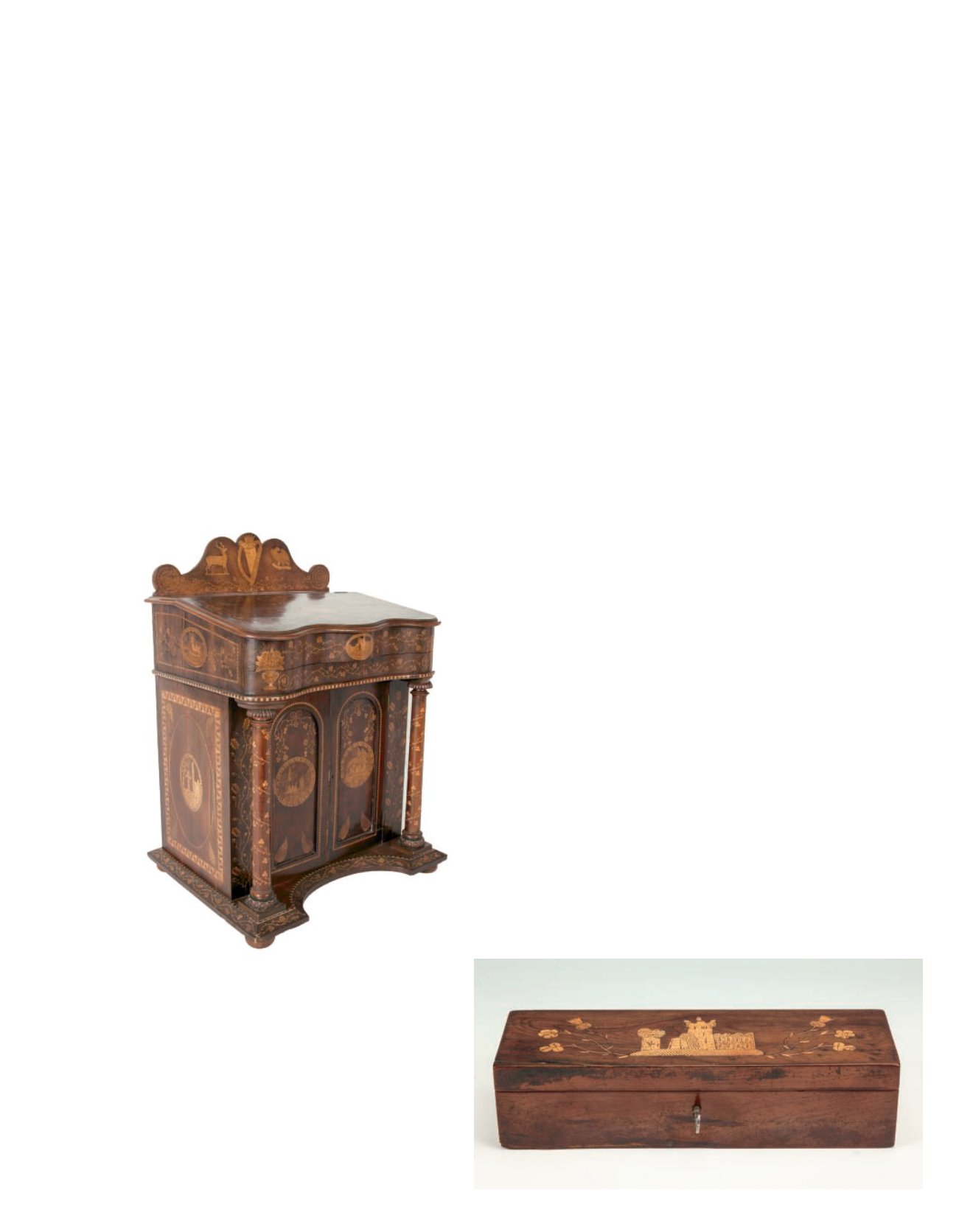
 401 A FINE IRISH VICTORIAN EXHIBITION
QUALITY KILLARNEY WORK ARBUTUS
OUTSIZED DAVENPORT DESK,
401 A FINE IRISH VICTORIAN EXHIBITION
QUALITY KILLARNEY WORK ARBUTUS
OUTSIZED DAVENPORT DESK,
the raised panel back, inlaid with a central crowned
harp flanked by eagle and deer above a slopefront
writing section, inlaid with vignettes of the ‘Swiss Cot-
tage’, the entire decorated with trailing shamrocks,
thistles and roses, signifying the three Kingdoms,
having a fitted interior and twin door cupboard base
with column supports, further decorated with oval
vignettes of Muckross House, etc.
80cm wide, 118cm high, 66cm deep
€ 7,000 - 10,000
402 AN IRISH VICTORIAN KILLARNEY WORK INLAID MAHOGANY AND ARBUTUS RECTANGULAR BOX,with trailing shamrock foilage depicting Ross Castle.
26cm x 9cm x 6.5cm
€ 400 - 600
A SMALL COLLECTION OF KILLARNEY WORK (LOTS 401 TO LOT 404)
‘Killarney-work’ as it is known is variously made from Bogwood, Arbutus and Yew and is associated in the main with the mid 19th Century man-
ufacture of both trinkets and larger items of furniture. The smaller items were made mainly for the burgeoning tourist trade in the region which
was beginning to enjoy its first real wave of popularity in the 1820s. An artisan by the name of John Neate is credited with being the first to man-
ufacture articles from Bogwood but it was his son-in-law, Cornelius Goggin who took the business onto a more successful level.
Brian Austen in his Irish Arts Review article lists quite a number of cabinet makers or manufacturers of this ware and suggests that even Dublin
makers such as Arthur Jones and Son were also creating the so-called Killarney-work pieces. It is difficult to differentiate between the work of one
manufacturer and another and very few stamped or labelled their work. Jeremiah O’Connor of Main Street, Killarney, who did stamp his work,
also produced a varied and substantial range of items from the largest Davenports to the most diminutive objects, card cases. The motifs of his
inlay work included the Irish Revival repertoire such as shamrock, wolfhounds and harps as well as castles and abbeys.
The London, Dublin and Cork exhibitions of the mid 19th Century provided these manufacturers with the opportunity to display, for a much
wider audience, more dramatic and complex articles of furniture such as Davenport desks, centre tables, games tables and desks, all decorated
with the signature views of the local Killarney beauty spots such as Muckross, Glena Cottage, Ross Castle and Killarney House. Other iconogra-
phy included forms which grow abundantly in the region, as well as eagles and deer. Brian Austen notes that wreaths and trails of shamrock,
rose and thistle are found in mid 19th Century items symbolising the Union of Great Britain and Ireland (lot 401) but are significantly absent
from later items. Clever marketing resulted in the purchase of various pieces by The Prince of Wales in 1858 and subsequently Lord Castlerosse
commissioned James Egan of Killarney to make a fine inlaid arbutus cabinet and desk for Queen Victoria’s visit in 1861. These more substantial
and decorative items of furniture were thus successfully aimed at the more discerning patrons including the Irish and English nobility and gentry
including the Earl of Clarendon, the Earl of Lanesborough, the Earl of Kenmare, the Earl of Eglinton, Viscount Hill and Lord Headley.
By the 1880s however the arbutus industry was in decline along with much of the indigenous furniture manufacturing trade in Ireland due in no
small part to the competition from British firms. Whilst they have always been prized amongst collectors, the demand, both national and inter-
national, for these highly decorative items began to see a resurgence in the late 1970s and 80s and has continued strongly to the present day.



















